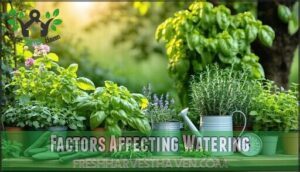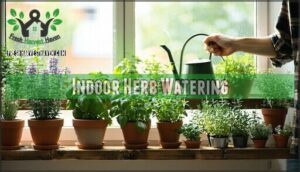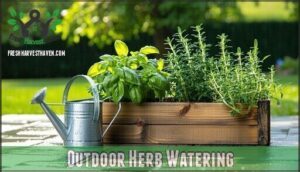This site is supported by our readers. We may earn a commission, at no cost to you, if you purchase through links.
 Your watering schedule for different herbs depends on their origin. Mediterranean herbs like rosemary and thyme need deep watering every 7-10 days when the soil feels completely dry. In contrast, leafy herbs like basil and parsley thrive with consistent moisture every 2-3 days.
Your watering schedule for different herbs depends on their origin. Mediterranean herbs like rosemary and thyme need deep watering every 7-10 days when the soil feels completely dry. In contrast, leafy herbs like basil and parsley thrive with consistent moisture every 2-3 days.
You’ll master this by doing the finger test: stick your finger 1-2 inches into the soil before watering. Mediterranean varieties prefer drought conditions between waterings, but leafy herbs should never dry out completely.
Climate, pot size, and seasonal changes affect timing, so adjust accordingly. Use room temperature water to prevent root shock, and water at soil level to keep leaves dry. Understanding these distinctions transforms struggling plants into thriving kitchen gardens.
Table Of Contents
- Key Takeaways
- Watering Herb Basics
- Herb Watering Schedule
- Factors Affecting Watering
- Indoor Herb Watering
- Outdoor Herb Watering
- Signs of Watering Issues
- Herb Specific Watering
- Frequently Asked Questions (FAQs)
- How often should you water herbs?
- Do herbs need different watering schedules?
- How do you water herbs?
- When should I water my herb garden?
- Do herbs need to be watered?
- How much water does a herb garden need?
- How often should herbs be watered?
- What herbs have similar watering requirements?
- How often should you water rosemary and thyme?
- What is the best watering schedule for plants?
- Conclusion
Key Takeaways
- You’ll need to match your watering schedule to each herb’s origin – Mediterranean herbs like rosemary and thyme thrive when you let the soil dry completely between deep waterings every 7-10 days, while leafy herbs like basil and parsley need consistent moisture every 2-3 days.
- Use the finger test as your primary moisture gauge – stick your finger 1-2 inches into the soil before watering, and you’ll quickly learn when Mediterranean varieties need their drought period versus when leafy herbs are getting too dry.
- You should water at soil level with room temperature water to prevent root shock and leaf diseases, applying deep watering sessions that encourage strong root development rather than frequent shallow watering that keeps roots near the surface.
- Your watering frequency needs to adjust for climate, pot size, and seasonal changes – small containers dry faster, hot weather increases evaporation rates, and winter herbs need significantly less water than their summer counterparts.
Watering Herb Basics
You’ll need to understand each herb’s unique watering requirements to keep your plants healthy and productive.
Each herb comes from different natural environments, so their water needs vary quite a bit. Mediterranean herbs like rosemary and thyme actually prefer their soil on the dry side.
Leafy greens such as basil and parsley need steady moisture to stay happy.
General Watering Guidelines
Getting herb watering right comes down to balancing moisture with good drainage.
Most herbs do well with watering 2-3 times per week, though your watering frequency really depends on how well your soil drains and the health of the root system.
Water deeply to help your herbs grow stronger roots and cut down on how much moisture escapes from the surface.
Feel the soil with your finger before you water—this tells you way more than sticking to a rigid schedule.
Good water matters too, so if your tap water is heavily chlorinated, let it sit out overnight before using it on your herbs.
Soil Moisture Check
The finger test provides the most reliable method for soil moisture testing in your herb garden. Insert your finger 1-2 inches deep into the soil to gauge moisture levels accurately. This simple technique beats expensive moisture meters for everyday gardening needs.
Visual soil inspections reveal additional clues about watering requirements. Dry soil appears lighter in color and feels crumbly, while adequately moist soil maintains a darker appearance and slight stickiness. Soil texture affects how quickly water drains and how long moisture remains available to your herbs.
Here are three proven methods for checking soil moisture:
- Finger test: Press your finger 1-2 inches deep to assess dampness levels directly
- Visual cues: Examine soil color changes and texture differences between wet and dry conditions
- Moisture meters: Use digital tools for precise readings when managing large herb collections
Check your drainage regularly to keep herb roots healthy and avoid both bone-dry soil and soggy conditions.
Watering Frequency Factors
Your watering schedule depends on several key things. What herbs you’re growing matters most – drought-loving rosemary and thyme can go days without water, while basil and parsley want their soil consistently moist.
Climate conditions and seasonal needs create varying demands throughout the year. Sunlight exposure increases evaporation rates, requiring more frequent watering.
Pot size affects water retention, with smaller containers drying faster. Soil drainage influences how long moisture stays available.
Microclimates around your garden create unique watering requirements for different areas.
Herb Watering Schedule
You’ll want a regular watering routine to keep your herbs thriving all season long.
Getting the watering frequency and timing right means your herbs get exactly what they need to flourish.
Watering Frequency
Understanding watering frequency helps you create an effective schedule for your herbs. Most herbs need water when the top inch of soil feels dry, usually every 1-2 times weekly. Your watering schedule depends on several key factors:
- Herb type: Mediterranean herbs like rosemary need less frequent watering than leafy varieties like basil
- Seasonal adjustments: Summer heat increases watering needs while winter reduces them greatly
- Climate impact: Hot, dry conditions require more frequent watering than cool, humid environments
Container size affects how quickly soil dries out. Small pots need more frequent attention than larger ones. Soil drainage also matters—well-draining potting mix prevents waterlogged roots while maintaining ideal intervals between waterings.
Watering Techniques
Once you’ve established your watering schedule, different herbs require specific watering techniques to get the most out of their growth potential. Healthy watering encourages strong root development by encouraging roots to grow deeper into the soil. Target the root zone directly rather than leaves to prevent disease and get the most water uptake efficiency.
Four essential herb watering techniques include:
- Direct soil watering – Apply water directly to soil, avoiding foliage contact
- Room temperature water – Prevents root shock from temperature extremes
- Moisture meters – Monitor soil moisture levels for precise irrigation timing
- Drip systems – Deliver consistent, controlled water distribution to root zones
Watering Tools
The right watering tools transform herb care from guesswork into precision. Moisture meters provide accurate soil readings, eliminating uncertainty about when to water. Watering cans with narrow spouts deliver targeted irrigation directly to the root zone.
Drip irrigation systems make certain of consistent moisture distribution across your garden. Self-watering pots maintain steady hydration automatically.
Soaker hoses work perfectly for larger herb gardens, while spray bottles provide gentle misting for delicate seedlings.
Factors Affecting Watering
Water needs for herbs aren’t one-size-fits-all. Climate, soil type, drainage, plant size, and what you’re growing them in all play a role in timing your watering right.
Your herb’s water needs change based on climate conditions, soil type, drainage capacity, plant size, and container choice.
Climate and Temperature
Temperature impact drives your herb watering decisions more than you might think. Hot weather accelerates water loss, requiring daily checks for container herbs. Seasonal changes dramatically shift needs—summer herbs need twice the water of winter ones. Regional climates create unique patterns, while microclimate effects around your garden produce localized conditions. To maintain healthy growth, follow best practices when watering your herbs.
- Temperature impacts above 85°F increase watering frequency for all herbs
- Hot weather causes rapid evaporation, especially affecting leafy varieties like basil
- Seasonal variations mean spring herbs need gradual watering increases
- Humidity levels below 40% require more frequent moisture monitoring
Soil Type and Drainage
Your soil composition plays a major role in herb watering success. Sandy soil drains fast, requiring frequent watering sessions. Clay soil holds water longer but creates drainage problems. Proper drainage prevents root rot while maintaining adequate moisture levels.
Consider these soil conditions:
- Well-draining sandy soil needs water every 2-3 days
- Heavy clay requires drainage solutions like perlite amendments
- Quality potting mixes balance water retention perfectly
- Amending clay with compost improves drainage naturally
Match your watering schedule to your soil type for healthier herbs.
Plant Size and Pot Type
Something about your container setup directly impacts watering frequency. Larger plants in small containers become rootbound herbs that need frequent watering. Container size and potting material determine drying rates – plastic retains moisture longer than terra cotta with better drainage holes.
Young herbs require less water than mature specimens. Monitor soil and container conditions closely. Consider repotting frequency based on plant size growth.
| Factor | Impact on Watering |
|---|---|
| Small containers | Faster soil drying |
| Rootbound conditions | Increased water needs |
| Terra cotta pots | Rapid moisture loss |
| Plastic containers | Slower evaporation rates |
Match your container gardening approach to each herb’s development stage for best results.
Indoor Herb Watering
Indoor herbs need different care than their outdoor counterparts because you control their humidity and light exposure. You’ll want to monitor soil moisture more carefully since containers dry out faster and drainage issues can develop quickly in enclosed spaces.
Humidity and Lighting
Indoor herbs face unique challenges with artificial lighting and humidity levels affecting their watering needs. Light intensity from grow lights or windows determines how quickly plants consume water through photosynthesis. Higher light spectrum exposure increases water uptake, while lower humidity levels cause faster soil drying.
Best placement near bright windows or under full-spectrum LED lights requires more frequent watering than dim corners. Consider these key factors:
- Monitor light duration – herbs under artificial lighting for 12+ hours daily need extra water
- Track humidity changes – heating systems drop humidity levels, increasing watering frequency
- Adjust for sunlight exposure – south-facing windows create different watering schedules than north-facing locations
Balance these environmental factors to prevent both drought stress and waterlogged roots in your indoor herb garden.
Soil Moisture Monitoring
Getting your soil moisture right saves your herbs from watering mishaps. Grab a soil moisture meter for exact readings, or just stick your finger about an inch down into the dirt.
Soil sensors and visual soil texture assessment help you understand drainage assessment needs.
Proper soil moisture management fosters root health and prevents overwatering damage.
Outdoor Herb Watering
When you grow herbs outdoors, you’ll need to adjust your watering schedule based on natural rainfall and seasonal temperature changes.
Check soil moisture regularly since outdoor conditions like wind and sun exposure can dry out your herb garden faster than expected.
Watering Schedule
Creating effective watering schedules for herbs requires customizing watering schedules based on growth phases. Your outdoor herbs thrive with consistent timing that adapts throughout seasons.
- Seasonal Adjustments – Reduce watering frequency for herbs during cooler months when growth naturally slows
- Automatic Timers – Install systems for consistent water quality delivery during busy periods or vacations
- Container Gardening – Monitor watering frequency for herbs in pots more closely than ground-planted varieties
- Growth Phase Timing – Adjust watering schedules for herbs from daily seedling care to established plant intervals
Sunlight and Rainfall
Weather patterns play a major role in determining your outdoor herb watering schedule. Sunlight intensity directly affects water evaporation rates from soil and leaves. During peak summer months, high sunlight exposure increases your herbs’ water requirements considerably. Rainfall patterns can either supplement or complicate your watering routine. Track local weather forecasts to adjust accordingly.
Seasonal variations create distinct watering phases throughout the year. Spring brings moderate needs, while summer demands frequent attention. Microclimate effects around your garden create unique conditions. Areas near walls or under overhangs experience different moisture levels.
| Factor | High Impact | Low Impact |
|---|---|---|
| Sunlight Requirements | Full sun herbs need daily checks | Shade herbs retain moisture longer |
| Environmental Factors | Wind and heat accelerate drying | Humid conditions slow evaporation |
| Water Collection | Slopes drain quickly | Level areas hold moisture better |
Monitor these environmental factors weekly to maintain peak growing conditions.
Signs of Watering Issues
You’ll spot watering problems early when you know what to look for in your herb garden. Watch for telltale signs like yellowing leaves, wilting stems, or soil that’s either bone-dry or waterlogged, and you can correct course before your plants suffer permanent damage.
Underwatering Signs
Spotting underwatering symptoms before damage occurs keeps your herb garden healthy. Your plants will send clear distress signals when they’re thirsty.
Wilting leaves serve as your first warning sign. They’ll feel dry and papery to the touch, often curling inward at the edges. Don’t confuse this temporary wilting with the dramatic drooping that happens from overwatering.
Watch for these four key underwatering indicators:
- Stunted growth where new shoots stop developing and existing foliage remains unchanged for weeks
- Dry soil that pulls away from container walls and feels bone-dry several inches down
- Leaf discoloration starting with pale green fading, followed by brown, crispy edges
- Soil moisture testing shows consistently low readings across different depths
Regular soil moisture checks help you catch these signs early. Insert your finger two inches into the soil around your herbs. If it’s completely dry at this depth, your watering schedule needs adjustment. Most herbs recover quickly once you restore proper moisture levels.
Overwatering Signs
When excessive moisture becomes your herb’s worst enemy, you’ll spot telltale warning signs. Yellowing leaves feel mushy instead of crisp, while waterlogged soil stays wet days after watering. Mold growth appears on soil surfaces, creating white or green patches.
When your herbs get too much water, you’re looking at trouble down the road – weakened roots that can’t breathe properly and fungal problems waiting to take hold.
| Overwatering Sign | What You’ll See |
|---|---|
| Yellowing leaves | Soft, mushy texture |
| Soil condition | Stays wet for days |
| Surface mold | White/green patches |
| Root health | Poor oxygen access |
Root Rot and Fungal Diseases
When excessive moisture lingers, root rot and fungal diseases threaten your herbs. Early detection saves plants—check for brown, mushy roots and sour-smelling soil.
Preventative measures include improving drainage with soil amendments like perlite. Remove affected plants immediately and consider fungicide use for severe infections.
Disease prevention beats treatment options every time.
Herb Specific Watering
Each herb has its own watering personality. Mediterranean herbs like rosemary and thyme actually hate soggy soil – they’re happiest when you let them dry out between drinks.
Meanwhile, leafy herbs like basil and parsley are the opposite – they want steady moisture and get cranky when they’re thirsty.
Smart gardeners group their herbs by water needs rather than fighting against what each plant naturally wants.
Watering Mediterranean Herbs
Mediterranean herbs like rosemary, thyme, and oregano showcase impressive drought tolerance and thrive with minimal watering. These sun-loving plants demand well-draining soil that completely dries between waterings.
Water deeply once weekly during summer, reducing frequency in winter watering periods. Excessive moisture diminishes their aromatic oils and triggers root rot. Your watering schedule should prioritize soil drainage over frequent irrigation for best herbs.
Using mulch can also help retain moisture and regulate soil temperature.
Watering Leafy Herbs
Nurture leafy varieties like basil, cilantro, and parsley with consistent moisture levels. These herbs demand more frequent watering than drought-tolerant Mediterranean types.
Check soil moisture by inserting your finger one inch deep—dry soil signals watering time. Water thoroughly until drainage occurs, maintaining your watering schedule for ideal foliar health and water retention.
Watering Fragrant Herbs
Fragrant herbs like mint, lavender, and chamomile produce their strongest aromatic plant watering when you balance moisture carefully. These drought-tolerant varieties prefer soil that dries between waterings. Check moisture levels weekly to maintain proper fragrance preservation and essential oil production for peak scented garden tips.
- Monitor soil moisture using the finger test—insert one inch deep before watering
- Water early morning to reduce evaporation and boost herb essence management
- Allow top inch of soil to dry completely between watering frequency cycles
- Group similar fragrant herb care needs together for efficient watering schedule maintenance
- Adjust herb watering techniques based on seasonal changes and humidity levels
Frequently Asked Questions (FAQs)
How often should you water herbs?
Water herbs 1-2 times weekly, checking soil moisture first. Mediterranean herbs like rosemary need less frequent watering, while leafy herbs like basil require consistent moisture for best growth.
Do herbs need different watering schedules?
You’ll discover that herbs are like different personalities – Mediterranean varieties such as rosemary and thyme thrive when you let them dry out between waterings, while leafy herbs like basil demand consistent moisture to stay happy.
How do you water herbs?
Check your herb’s soil moisture by inserting your finger one inch deep. Water thoroughly when the top inch feels dry, allowing excess water to drain completely from the bottom.
When should I water my herb garden?
Picture your herbs basking in morning sunlight, leaves glistening with dewdrops.
Test soil moisture by inserting your finger one inch deep. Water when the top inch feels dry, usually every 2-3 days during growing season.
Do herbs need to be watered?
Yes, herbs absolutely need water to survive and thrive. They require it for photosynthesis, nutrient uptake, and growth.
However, different herbs have varying water requirements based on their origins and tolerance levels.
How much water does a herb garden need?
Most herbs need about one inch of water weekly. Mediterranean herbs like rosemary need less, while basil requires consistent moisture. Check soil depth with your finger before watering.
How often should herbs be watered?
Most herbs need watering every 2-3 days, but it depends on the type. Mediterranean herbs like rosemary prefer drying out between waterings, while leafy herbs like basil need consistent moisture.
What herbs have similar watering requirements?
Mediterranean herbs like rosemary, thyme, and oregano share similar drought-tolerant watering needs.
Group basil, parsley, and cilantro together since they prefer consistent moisture. This pairing simplifies your watering routine a lot.
How often should you water rosemary and thyme?
Water rosemary and thyme every 7-10 days during growing season, letting soil dry completely between waterings. These drought-tolerant herbs prefer infrequent, deep watering over frequent light applications.
What is the best watering schedule for plants?
Like tending a garden clockwork, you’ll want to water most plants deeply when the top inch of soil feels dry.
Check soil moisture regularly, water early morning, and adjust frequency based on plant type, season, and environmental conditions.
Conclusion
Getting your herb watering right comes down to understanding where each plant originally grew. Mediterranean herbs like rosemary and thyme evolved in dry climates, so they actually prefer drought conditions with deep, less frequent watering. Meanwhile, leafy herbs such as basil and cilantro thrive with steady moisture.
Mediterranean herbs thrive on neglect while leafy varieties demand steady attention—match your watering to their homeland, not your schedule
Stick with the finger test, watch how seasons affect your plants, and tweak your approach based on your specific setup. These proven methods will keep your herbs healthy and productive, giving you fresh flavors for cooking all year long.
- https://www.southernliving.com/how-often-to-water-basil-11769378
- https://swanhose.com/blogs/watering-herbs/a-comprehensive-guide-to-outdoor-indoor-basil-watering
- https://savvygardening.com/how-often-to-water-basil/
- https://www.reddit.com/r/gardening/comments/184gygt/how_much_water_does_rosemary_need/
- https://plantura.garden/uk/herbs/thyme/thyme-plant-care














